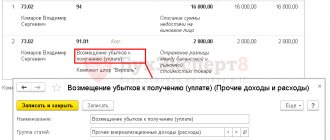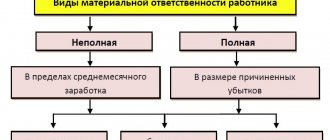Drawing up an act of refusal to write an explanatory note occurs in cases where an employee of an organization commits any offense, but does not want to give any explanations about it.
- Form and sample
- Free download
- Online viewing
- Expert tested
FILES
At the same time, the significance of the violation itself is determined by the superior boss - if, guided by the legislation of the Russian Federation and the internal regulations of the company, he considered it serious enough, then he has every reason to request an explanation from his subordinate.
Whether to give them or not, each employee decides independently - according to the law, drawing up an explanatory note is not an obligation, but an employee’s right, and no one has the right to force him to do this.
The procedure for giving explanations for an offense
Any violation committed by an employee must be recorded in a special act. This document is drawn up by his immediate superior with the involvement of at least two witnesses (also employees of the organization).
The act must record:
- time,
- place of the offense committed
- the essence of the offense.
Next, the manager is obliged to demand an explanation from the subordinate. In this case, the employee has the right to give them both orally and in writing .
Written documents are necessary only if they allow you to analyze and evaluate the weight and validity of the reasons for the offense and can directly affect the severity of the possible punishment.
By law, the period for requesting and issuing an explanatory note may be determined by the company’s internal regulations, but in any case, it should not exceed one month.
If an employee writes an explanatory note, then in the future it either serves as a justification for releasing him from punishment, or becomes the basis for an order to impose a disciplinary sanction.
If the employee refuses to give written explanations, then after three days the employer has the right to draw up a corresponding act.
Refusal to give explanations by an employee: employer's procedure
In order to maintain labor discipline, employers have the right to impose disciplinary sanctions on employees in the manner prescribed by Art. 192 of the Tax Code of the Russian Federation. Thus, in response to non-fulfillment or incorrect performance of duties by an employee, the employer has the right to:
- reprimand him;
- reprimand;
- fire an employee.
It is also possible to apply other disciplinary measures established for certain categories of employees by separate legislative acts (for example, Federal Law “On State Civil Service” dated July 27, 2004 No. 79-FZ or “On Service in Internal Affairs Bodies” dated November 30, 2011 No. 343-FZ).
However, before applying disciplinary action, the employer must request an explanation from the employee regarding the action or inaction in writing. If the employee does not provide it within 2 working days, the employer must draw up a report indicating this (paragraph 1 of Article 193 of the Labor Code of the Russian Federation).
This act is most often used as a document confirming the existence of grounds for dismissing an employee in accordance with paragraph 5 of Art. 81 of the Labor Code of the Russian Federation: dismissal from office due to repeated violation of one’s labor duties in the presence of a disciplinary sanction.
By providing an explanatory note, the employee can convince the employer not to impose a penalty. But the absence of such a document cannot be an obstacle to the application of this disciplinary measure by the employer (paragraph 2 of Article 193 of the Labor Code of the Russian Federation).
The role of explanatory
It is difficult to overestimate the importance of an explanatory statement - it helps the management of an enterprise understand the motives for committing an offense and determine the degree of guilt of the offender.
And although the presence of an explanatory note on the part of the employee does not oblige the employer to release him from punishment, in some cases, if the reason for committing the offense was sufficiently compelling and respectful (for example, the illness of a close relative, force majeure, etc.) and to the explanatory note supporting documents are attached, the manager does not have the right to impose disciplinary sanctions .
Why is the act needed?
The role of the act of refusal to write an explanatory note is also quite simple and understandable: this document, being proof of the commission of an offense and lack of remorse on the part of the offending employee, gives the full right to the management of the enterprise to take measures to punish him.
Disciplinary action has three most common forms:
- comment,
- rebuke,
- dismissal.
It is one of them that is indicated in the order by the director. The more serious the violation, the more serious the responsibility for it.
When violating labor discipline, you need to remember responsibility
An employee who has committed a disciplinary offense can be held accountable by applying disciplinary measures to him.
Failure to fulfill or improper performance of labor duties assigned to an employee is called a disciplinary offense (Article 192 of the Labor Code of the Russian Federation).
Labor legislation establishes a list of disciplinary sanctions that can be applied to an offending employee (for more information, see “Types of disciplinary sanctions under the Labor Code”):
- comment;
- rebuke;
- dismissal.
These types of penalties are in order of increasing responsibility depending on the severity of the offense. That is, a reprimand is the mildest measure of disciplinary action, and dismissal is the most severe (for more details, see “Dismissal is a type of disciplinary sanction”).
The sample order for disciplinary action will differ depending on what type of punishment is chosen:
- a sample order for a disciplinary sanction in the form of a comment (for more information, see “Drawing up an order for a disciplinary sanction in the form of a comment (sample)”);
- a sample order for a disciplinary sanction in the form of a reprimand (for more information, see “Issuing an order for a disciplinary sanction in the form of a reprimand (sample)”);
- a sample order for a disciplinary sanction in the form of dismissal (for more information, see “We issue an order for a disciplinary sanction in the form of dismissal”).
Who draws up the act
Usually, the act of refusal to write an explanatory note is drawn up by the head of the structural unit in which the employee who committed the violation works.
In order for the act to gain legal force, it is necessary to involve other employees of the company in writing it, as witnesses to the refusal.
In other words, to draw up the act, a special commission of at least three people is formed, which must include the employee’s immediate supervisor, and, for example, a legal adviser and the company secretary.
The law does not in any way define the list of employer representatives who can certify the fact of an offense and refusal to write an explanatory note, therefore, at each enterprise, a commission is appointed on an individual basis.
If there is a trade union body in the organization, its representative must also be included in the commission.
We draw up an act of refusal of the explanatory note: who draws up and signs the document
The legislator does not determine the list of persons authorized to draw up and sign an act of refusal of the explanatory note. However, based on the logic of its use as one of the documents establishing the grounds for dismissal of an employee, we can conclude that it must be drawn up and signed by 2 groups of persons:
- Firstly, employees who identified the fact of violation of labor discipline by the employee and obliged him to provide an explanatory statement. As a rule, this is his immediate supervisor, as well as a representative of the personnel service. At the same time, these employees perform both functions - they draw up and sign the corresponding act.
- Secondly, a commission formed similar to the one that certifies employees in order to determine the compliance/non-compliance of their qualifications with the position held. In this case, the purpose of the commission is to certify the fact that the drafters of the act recorded the employee’s refusal to write an explanatory note about the violation of labor discipline he committed. Thus, the commission endorses the act under consideration, assuring the correctness of the wording of the document’s drafters.
In accordance with paragraph. 3 tbsp. 82 of the Labor Code of the Russian Federation, the certification commission must include a representative of the trade union body (if the company’s employees are members of a trade union). The presence of a trade union representative on the commission certifying the employee’s refusal to give explanations is also desirable.
Thus, the act must be drawn up:
- head of the HR department of the enterprise;
- the employee's immediate supervisor.
In turn, the act must be signed by the same persons, as well as:
- members of a commission formed by analogy with the certification commission;
- representative of the trade union body.
In addition, the document must be signed by the employee himself. Moreover, if he refuses to sign the document, the head of the HR department is recommended to write by hand in the place where the employee’s signature should be, the phrase: “Refused to sign.”
Or you can include a special block in the structure of the act, where there will be the phrase: “I refused to sign this document,” as well as a place to indicate the full name, position of the head of the personnel service and his signature. This block can be placed next to where the employee’s signature should be.
Sample act of refusal to write an explanatory note
Today there is no single unified sample for drawing up an act of refusal to write an explanatory note, so company employees are free to write it in any form or according to a template that operates within the company.
However, there are some data that must be indicated in the act:
- number, date, place of document preparation,
- Name of the organization,
- position, surname, name, patronymic of the offending employee,
- composition of the commission certifying the refusal to give explanations,
- the reason why the employee was required to write an explanatory note and reference to the relevant law.
The scope of the act is not limited, so the main section can be supplemented with any other information.
After an offense we demand an explanation
Immediately after committing a disciplinary offense, the employee must write an explanatory note. This document will be attached to the memo on violation of discipline (disciplinary act).
It is clear that the explanatory note must be written by the employee personally and addressed to the head of the enterprise. The legislation does not establish a uniform form for such a document, so the explanatory note can be written in any form (for more information, see “Drawing up an explanatory note about being late (sample)”, “Drawing up an explanatory note about failure to fulfill duties (sample)”).
In practice, it happens that an employee does not provide an explanation within the period established by law. In this case, you need to prepare an act of refusal to give explanations. There is no form approved by labor legislation, so this document can be drawn up in any form. The main thing is to obtain the signature of at least two witnesses who can confirm the fact of refusal to give explanations (Article 193 of the Labor Code of the Russian Federation).
Especially for our readers, our specialists have prepared a sample act of refusal to give explanations by an employee.
How to draw up a deed
The legislation does not impose any special requirements on both the information part of the act and its execution: the document can be printed on a computer or written by hand, on a simple blank sheet or on company letterhead.
It is important to comply with only one condition: the act must be signed by the direct compiler, as well as by the members of the commission who were present at its creation. It is advisable to obtain the autograph of the offending employee, and if he refuses, an appropriate note should be made in the document.
It is not necessary to certify a document with a seal, since from 2021 legal entities are exempted by law from the requirement to use stamps in their activities.
It is enough to draw up the act in a single copy, but if necessary, you can make the required number of copies.
Drawing up an act of refusal of the explanatory note: how to reflect the substantive facts
As we defined above, the act of refusal of the explanatory note is drawn up by the manager of the employee who committed the violation of discipline and a representative of the personnel service. Accordingly, the essence of the incident is presented on behalf of these specialists.
However, there is a nuance: the drafters of the act must indicate that the facts reflected in the document are certified by a special commission. The easiest way to do this is by transferring the authority to draw up the act to the commission by including in the document a phrase stating that the commission has drawn up this act, confirming that:
- in the presence of the drafters of the act (indicating their full names and positions) on such and such a date, the employee was asked to give an explanation in writing about the disciplinary offense, for example, being late for work by an hour;
- as of such and such a date, the employee, as required by Art. 193 of the Labor Code of the Russian Federation, did not provide the corresponding explanatory note.
Immediately after the text block, you can indicate the full name and position of the drafters of the act, the commission, the employee himself, and also affix their signatures.
A sample of an act of refusal to write an explanatory note was prepared by ConsultantPlus experts. Get free demo access to the system and proceed to the sample document.








